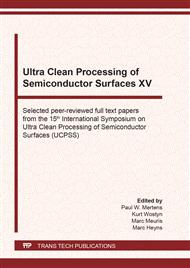p.197
p.202
p.209
p.214
p.218
p.222
p.228
p.237
p.247
Particle Removal in Ultrasonic Water Flow Cleaning Role of Cavitation Bubbles as Cleaning Agents
Abstract:
Visualization experiments are performed to examine the role of acoustic cavitation bubbles that appear in 0.43-MHz ultrasonic water flow spreading over glass surfaces in the context of physical cleaning. The cleaning performance is evaluated using glass samples on which small silica particles are spin-coated. The visualization suggests that acoustic cavitation bubbles play a major role in particle removal as in the case of conventional cleaning with ultrasonic cleaning baths.
Info:
Periodical:
Pages:
218-221
Citation:
Online since:
February 2021
Authors:
Permissions:
Share:
Citation:


